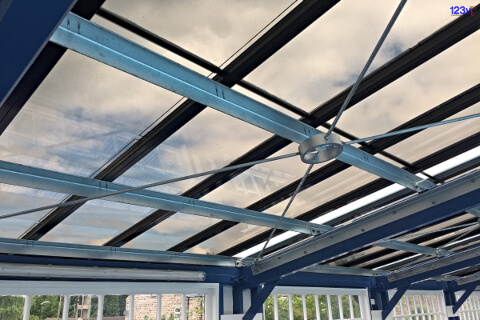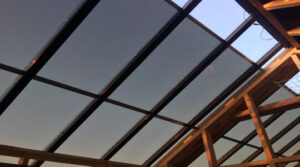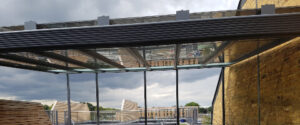Benefits of Solar Carports & Canopies

The Cost of Living Crisis & Fossil Fuel Dependence
The UK’s energy crisis has been one long steady torrent of bad news – a trend that shows no sign of reversing anytime soon. The Energy Price Guarantee caps average energy bills at £2,500 annually – 27% than summer 2022, and 96% higher than the winter 2021/22 price cap. During this period, the price of gas has risen 141%; the price of electricity by 65%.
Nonetheless, there are fears that the average bill could spike to £4,300 a year when the EPG comes up for review in April; more and more customers are being left with real questions over how they can afford to pay their bills. Inflation is as high as it’s been since 1981, real income is set to drop 4.1% across 2022 – and NIESR research reckons that total bills are outweighing income for around 60% of Britain.
The outlook is undeniably concerning, yet the energy crisis seems to have a clear and simple solution – to commit wholeheartedly to renewable energy sources, and reduce our reliance on fossil fuels.
For decades, we’ve understood the damaging impact of burning fossil fuels – despite being the biggest contributor towards climate change, they still provide around 80% of the world’s energy. Climate Change is acknowledged internationally by the Paris Climate Agreement. The agreement aims to reduce greenhouse gas emissions and achieve climate neutrality by the middle of the 21st century. Companies across a number of sectors have introduced trailblazing initiatives in pursuit of becoming Carbon Neutral and Net Zero by 2030, 2050 and so on – yet the UK government appears to be singing from a different hymn sheet.
The North Sea Transition Authority has recently begun awarding 100 new licences to drill for fossil fuels; the campaign group Paid to Pollute claims the government handed out £13.6bn to oil and gas companies between 2016 and 2020.
Meanwhile, renewables – like solar, wind and hydro – offer an unlimited supply of clean energy, and are getting cheaper all the time. While the price of gas continues to skyrocket out of control, the cost of solar-powered electricity fell 85% between 2010 and 2020.
Equally, committing to renewables makes long-term economic sense: the IMF claims $5.9 trillion went towards subsidizing fossil fuels in 2020 alone; if the world spent $4 trillion a year on renewables through 2030, we could hit net zero by 2050. And start to save $4.2 trillion a year from 2030 onwards.
Incremental household changes are impactful for the environment as well as for reducing energy consumption and bills. Solar carports and canopies can make a difference
Of course, we’d forgive you if you read all this and felt a little helpless. The world’s energy problems seem so big: it’s easy to think ‘what can I do?’
But little things can make a massive difference – and with every single person that commits to renewable energy, the strain on the world eases just a little.
Now imagine if your whole street, your whole neighbourhood or even your whole city prioritised sourcing clean, green energy. How much carbon could be saved? How much better would we feel, knowing we were doing our best to protect Mother Nature? And how quickly would a more stable, sustainable future for the world emerge?
Of course, there’s only so much that you can do in a domestic setting – and it is unrealistic to expect people to install wind farms or hydro dams at home. However, the experts at 123v have struck on Solar Carports and Solar Canopies as an efficient and convenient source of renewable energy – which can help reduce your bills and contribute towards a cleaner, more sustainable future.
You might well be asking, ‘why not just stick a few panels on my roof?’. But since so many houses were built prior to the advent of solar – or without solar panelling in mind – it may not be so simple. A Solar Carport or Canopy may be easier to install and maintain, and could well end up offering better savings.
How much could you save?
Based on 10 percent light transmission, a 22 sqm canopy (6m x 3.6m) can generate 4.3kWp using crystalline silicon technology, and 2.2kWp using CdTe solar PV technology at any one time. So, somewhere like London, you would expect to generate between 2000 kw and 3800kW hours, depending on which technology you are using.
Now, the Energy Savings Trust puts the average price of electricity as £0.34/kWh.
Using an example of a 5.47m x 3.626m canopy (e.g big enough to be a carport of garden canopy) as guidance. This arrangement with a glass canopy 10% light transmission would deliver 3.6kWpeak or approximately 3300kW hours per year, if South facing and located somewhere like London. This equates to savings of £1,120 per year based on the government price capped electricity averaging at 34p/kWh. Of course this is lower due to the price cap and so can be expected to increase in future years.
What are Solar Carports?
A Solar Carport is a covered parking area, where the roof or canopy is comprised of solar panels – essentially a ground-mounted solar panel with space for your car underneath.
Solar Carports have the dual benefit of protecting your vehicle(s) from the elements, while also providing a clean and cost-effective source of energy.
Carports are an extremely flexible form of solar tech – since they do not require a land investment, but rather make use of the existing space where you park your car. They can be installed in a residential or commercial setting, covering a single parking space or an entire parking lot. Users can install their carport at the optimal angle to maximise sunlight exposure.
There are several competing solar – or photovoltaic (PV) – technologies, all of which work in slightly different ways. The dominant technology, generally used for Solar Carports, is crystalline silicon: a crystal is grown and sliced into wafers, attached to a backing material and protected by glass, with cells wired together.
What are Solar Canopies?
Solar Canopies function in the same way as Solar Carports, but rather than providing space for your vehicle, offer shaded spaces within the domestic setting – especially in gardens and courtyards. Glass solar panels allow some light to pass through the structure, while simultaneously generating energy.
Since Solar Canopies are generally made up of partially transparent photovoltaic glazing, we use an alternative technology called thin film solar PV. This calls for a transparent anode and cathode to be deposited directly onto the glass – alongside a thin layer of light-absorbing material such as CdTe, which is sandwiched between the glass.
Benefits of Carports and Canopies:
1. Saving energy and cash
Solar panels’ number-one selling point has always been savings. Installing a Solar Carport or Solar Canopy can save you cash by considerably cutting your electricity bill. If large enough, your solar panels may end up covering your entire electricity bill.
It is worth bearing in mind that you’re likely to generate eight times as much solar power in July as you will in December; and that you will probably generate less power than the above figures if you are based further north or further from the sea.
Of course, switching to solar saves more than mere money. Installing a Solar Carport or Solar Canopy can ease the strain on the UK national grid – which has been struggling to deal with the burgeoning demand of electric cars and boiler heaters.
Solar Carports and Canopies can also help to preserve the world’s fast-depleting fossil fuel supplies, while helping individuals reduce the size of their carbon footprint. The Energy Saving Trust claims a typical home solar system could save 1.3 to 1.6 tonnes of carbon annually.
2. Protecting your car
Energy aside, a Solar Carport offers the benefit of protecting your car against the elements. Sun exposure is often the biggest bugbear – it can cause paint to fade, interiors to crack, and can even disintegrate convertible roofs – but rain, snow, wind and falling tree sap can equally damage your automobile.
Installing a Solar Carport ensures that you can park your car in peace – without worrying about what kind of harm nature might cause overnight. Never again will you face the torment of clearing animal droppings from your windscreen – your carport will save you time, headaches and money that might otherwise have been poured into maintenance.
All this while generating clean energy and helping you to cut your bills? It almost sounds too good to be true . . .
3. Safely and securely housing solar panels
‘Why bother with a carport, when I can just stick solar on my roof?’
It’s a question we’ve heard time and again – since most consumers don’t realise that solar panels can’t always be simply and safely retrofitted onto buildings.
There are a number of reasons why your house might not be suited to solar panelling. For, example, if you have a wooden roof, fitting solar panels may represent a fire risk.
Equally, if you live in an older building – and aren’t totally confident about your roof’s lifespan – you may want to hold off on domestic solar panelling. Were your roof to spring a leak, you’d have to remove the panels to conduct repairs, and reinstall them once the work has been done. And that’s not to mention the extra strain solar panelling might put your roof under.
Of course, installing solar panels onto your house won’t be an efficient solution if your roof is shady, small or at an unfavourable angle. Essentially, roof-mounted solar panels aren’t the ‘one size fits all’ solution they’re often made out to be.
This is where Solar Carports and Solar Canopies come in. Since these don’t require retrofitting, installation and maintenance are often much more straightforward. What’s more, carports can be angled so as to maximise their efficiency – and often harness power more effectively than domestic solar panels.
4. Powering your electric car
Electric vehicles are a cornerstone of a more sustainable future, right?
While the answer is emphatically yes, the equation isn’t as simple as we often assume. That’s because, if you power your EV off the national grid, some of that electricity will have been generated by burning fossil fuels.
If that all seems a little complicated, you can simplify things by building a Solar Carport or Canopy which doubles up as a charging station. You will need a little extra tech – a solar battery and a PV inverter – but getting set up is fairly straightforward. And oh-so worth it, since you can drive to your heart’s content without worrying about burning fuels – and what they’ll do to your bank balance or to the wider world.
5. Flexible and customizable
Another advantage Solar Carports and Canopies have over roof-mounted solar systems is their flexibility and customizability.
Indeed, Solar Carports and Solar Canopies are generally constructed as a response to a certain space – rather than being retrofitted. They come in all shapes and sizes – and can be extended, modified or moved more easily than roof-mounted solar panels.
So, if you decide to move house, chances are you’ll be able to take your Solar Carport or Canopy with you – alternatively, if you decide to leave your solar system in place, it will add value to your property.
If you would like a brochure providing more detailed information on any of 123v’s products, or require a free quote or survey – why not contact us today?



